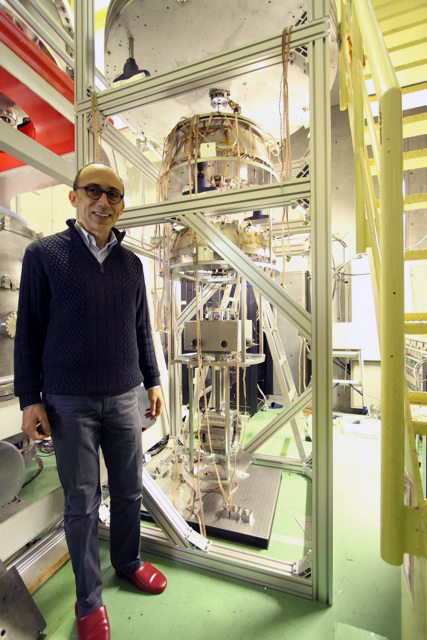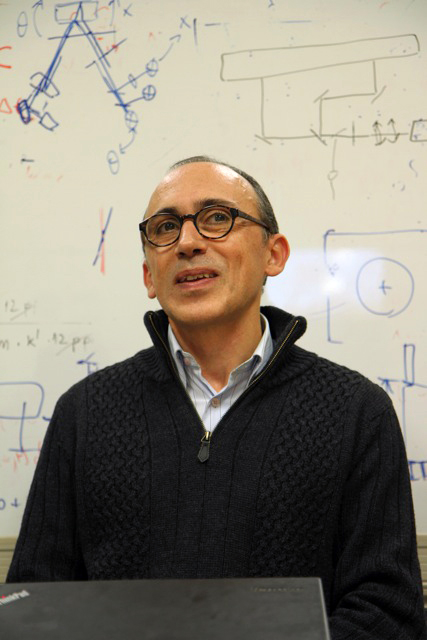重力波プロジェクト推進室長 ラファエレ・フラミニオ博士 インタビュー [4/4]

KAGRAに搭載される防振サスペンション・システムの一部
――たとえば地面振動のような重力波以外の振動はどのように取り除くのでしょうか?日本は地震の多いので伺いますが。
How do you get rid of all of the other vibrations, like seismic vibrations since we are in Japan where there are many Earthquakes?
Flaminio:いろいろな方法がありますが、まずは古典的な話をしてみましょう。私たちは防振系をつかっています。それは基本的には振り子とばねでできていますが、防振系をつかって地面から鏡を浮かせています。車のサスペンションが道路の凸凹で揺れるのを軽減するのに似ています。もちろん私たちがつかっている防振系は、自動車でつかわれているのよりもずっと高度なものですが。KAGRAでは、13mの高さにまでいくつもの振り子とばねを連ねることで、10Hz付近では、地面から鏡に伝わる振動を10億分の1以下に抑えようとしています。
Well in that case the solutions are more, shall we say classical. We use a vibration isolation system which is basically pendulums and springs that isolate the mirrors from the ground. In a way, it is similar to the ones that are used for suspending cars so that you don’t feel too much the vibration due to the road. Of course it is pushed much farther. So in KAGRA we use a chain of pendulums which is something like 13 m tall, with several pendulums and several springs so that the vibrations from the ground reaching the mirrors are reduced by more than 10 billion times at frequencies like 10 Hz.
偽物の信号を判別して除外することは、とても大事なことです。特に観測をはじめた時には。重力波の検出は、他の観測と比べて独特の利点があります。重力波は地球を通り抜けることができます。つまり、重力波が地球にやってくれば、地球上のどの望遠鏡でも同じ信号を捉えることができるのです。それがどんな信号であれ、他の重力波望遠鏡で受けたものと一致しているかどうかを確かめることができます。そういう意味で、他の望遠鏡と協力することは、KAGRAだけでなく他の全ての重力波望遠鏡にとって、とても大切なことなのです。心しておかなければならないことは、特に初めて重力波を検出するときは、自分たちが何を見ているのかについて、本当に確信を持てなければなりません。ですから他の望遠鏡と協力して、データを共有することは本質的に重要なことなのです。
Removing spurious signals we should say is the most important thing. Especially at the beginning. We can take advantage of something which is probably unique compared to other fields, which is that the Earth is transparent to gravitational waves. So a gravitational wave, as it passes through the Earth, should leave the same signal on different detectors on Earth. So this means that we can check whatever the signals we see are consistent. And so for that sense, having a collaboration with other detectors is very important for everybody, not just for KAGRA. What you must understand is, especially for the first detection, you need to be sure of what you are looking at, and so this possibility to collaborate and exchange data with other detectors is really fundamental.
――重力波がどちらの方向から来たのかは、どうして分かるのでしょうか。
How do you determine what direction a gravitational wave came from?
方向を決めるには三角測量を使います。さきほども言いましたように、同じ事象を、地球にあるどの重力波望遠鏡でも見ることができます。ですから、信号を他の望遠鏡のデータと見比べて確かめる、と言いましたが、単に比べて確かめているのではなくて、実際はもっと踏み込んだことをします。地上の重力波望遠鏡のデータはひとつにまとめられます。LIGOとVIGROは、すでに観測データを統合して解析をした実績があります。KAGRAもそのようなデータの統合を視野に入れています。KAGRAはLIGO, VIRGOと既にMOU(了解覚書)を交わしているので、将来的には全ての重力波望遠鏡のデータは、ヨーロッパと日本、それにアメリカにある別々の計算機センターに送られ、科学者たちはデータを共同で解析することができるようになるでしょう。最終的には、それぞれの望遠鏡から集められた信号を見比べて、それぞれの望遠鏡に重力波が届いた時間の差を見ることで、重力波がどちらの方向から来たのかを知ることができます。望遠鏡が最低3つあれば、だいたいの方向が分かります。あとは精度の問題になりますが、望遠鏡の数が多ければそれだけ重力波が空のどこから来たかをはっきりと指し示すことができます。どれくらい正確にその位置を示せるかは、もちろん信号の振幅にもよりますが、信号が大きければ大きいほど、より細かく波源の方向を指し示すことができます。たとえば、中性子星連星やブラックホール連星の場合には、天球上の角度にして数度くらいの精度で重力波の到来方向を示せるようにしたいものです。それは、光赤外望遠鏡や電波望遠鏡の視野と比べると広すぎるかもしれませんが、それでも他の望遠鏡をそちらに向けて、重力波のほかにも何かが起こっていないか探査することはできるでしょう。
That’s a triangulation. As I said, the same phenomenon should be visible to different detectors on Earth, and so when I said that you check the signal with other detectors, actually you do more than that. Actually in reality, the data coming from these detectors are merged together. LIGO and VIGRO already did that in the past to have their data merged together and KAGRA is already foreseen to do that. We already have a memorandum of understanding with the LIGO and VIRGO projects, so that all the data will go to different computing centers in Europe, in Japan, in the United States, and then the scientists actually analyze the data jointly. So in the end, by looking at the signals coming from different detectors, by looking at the times the signals arrive at different detectors, you can say from which direction it’s coming. With 3 detectors, you can say where the signal is coming from. Then it’s a matter of the precision with which you can actually pinpoint the direction in the sky. And of course that depends on the amplitude of the signal; the larger the signal, the better you can point. For example in the case of binary neutron stars and binary black holes, we should be able to point in the sky with the precision of a few degrees. Which is big compared to optical telescopes or radio telescopes, but still is probably sufficient to point other kinds of telescopes in that direction, scan the sky, and see if there is something else more than gravitational waves.
――一般相対性理論と天文学についての興味深いお話をありがとうございます。少し個人的な話に移りますが、どうして研究者になろうと思ったのか、お伺いしてもよろしいでしょうか。
Could you please describe the path that led you into research?
私は、母が高校で数学を教えていて、父は大学の物理学の教授をしている、という家庭で育ちました。子どものころは、CERN *1のパンチカード *2で遊ぶような環境で過ごしました。父が仕事で何をしているのかを初めて知ったときの衝撃を今でも覚えています。彼は素粒子物理学者でした。私はその研究に心を奪われました。自分も科学に携わることができるかもしれない、そして基礎科学に基づいて宇宙を理解し、また逆に天体現象から基礎科学を理解することができるかもしれない、と思ってわくわくしました。
I’m coming from a family where my mother was a professor of mathematics at a high-school and my father was a professor of physics at a university. I was playing with punch cards at CERN when I was a little boy. So I have been in that environment for a while. I still remember the surprise in my head the first time I realized what my father was doing at his job. He is a particle physicist. I remember that I was very much fascinated about that. I still remember that I was very excited by the possibility of doing science, and also the possibility of using science to understand astronomy and the opposite.
いろいろ考えた末、私は物理の勉強をはじめました。そして天体物理学と物理学のつながりに夢中になりました。それで、私はその天体物理と物理の間で研究をしていきたいと思いました。
After some thought I started studying physics, and I was very much fascinated by this link between astrophysics and physics. So I wanted to do something in the middle.

――なぜ天体物理学のなかでも重力波を研究しようと思われたのでしょうか。
How did you decide to study gravitational waves from the diverse field of astrophysics?
Flaminio:私は天体素粒子物理学とよばれる分野に強い興味を持ちました。天体素粒子物理学の考え方には2つの側面があります。ひとつは、新しい装置をつくって宇宙を観測する、もう一方では、基礎物理学をより深く理解するために宇宙を使う、というものです。それで、基礎物理学と天体物理学の境界にあるこの分野で研究をしたいと思いました。重力波は、自分にぴったりだと考えたのです。重力波で宇宙を見ることは、今まで誰もしたことのない、本当に新しいことでした、ですから私は重力波の研究に加わることにしました。それはたぶん25年くらい前のことです。そして、今、私はそのような道を選んで本当に良かったと思っています。もうすぐ、目標に到達することができるだろうと思います。
I was really interested about this field which we call astro-particle physics, which is this idea of on one side observing the Universe with new instruments; and on the other side, using the Universe to have a better understanding of fundamental physics. So I wanted to be in that field at the boundary between fundamental physics and astrophysics. And I think that gravitational waves are easily the field which best fits. Because looking at the Universe with gravitational waves is something really new that nobody had done before. So I decided to join gravitational wave research. That was maybe 25 years ago. And I think I’m happy about the choice I made. I hope we will be able to reach the goal soon.
――国立天文台に来ようと思ったのはなぜですか。
Why did you come to NAOJ?
私が最初に日本を訪れたのは1990年代でした。当時、三鷹ではTAMA300の建設が進んでいました。率直に言って、大変気に入りました。ですが、そのときはVIRGOに関わっていて、結局随分長い間そのプロジェクトで働きました。KAGRAの建設が決まったとき、日本でもう一つの望遠鏡ができることは素晴らしいと思いました。私は、重力波を捉えて重力波天文学を創成するためには、できるだけ多くの望遠鏡が必要だと信じていました。それにKAGRAには、私が今まで経験してきたことにはない特徴がありました。たとえば望遠鏡が地下にあることや、低温の鏡にまつわるあれこれです。ですから、ぜひともKAGRAに協力したいと思いました。私には、VIGROで働いてきた経験があります。その経験はKAGRAの役に立つでしょうし、ここに来てKAGRAに協力することは、私にとっても面白いだろうと思いました。
I visited Japan for the first time in the 90s, when TAMA was under construction. And I should say that I liked it a lot. Then I continued to work in VIRGO, but I’ve been working in the VIRGO project for many years. And when KAGRA was approved, I was excited about the possibility of having another detector in Japan. I’m really convinced that it is important to have as many detectors as possible, to get to the goal and to start doing Astronomy. And there were features in the KAGRA project that were different from what I’ve done before. Like having the detector underground, and things related to cryogenic mirrors. So I decided that I wanted to help. I had collected some experience working in VIGRO. I thought it may be useful for KAGRA and also interesting for me to come here and help on this project.
KAGRAとVIRGO、そしてLIGOはよく協調しています。よく一緒に会議を開いています。ですから、あるプロジェクトを去って別のプロジェクトに移った、というより、KAGRAに協力することで同じ目標に向かっていると感じています。
KAGRA, VIRGO, and LIGO are really all working together. We have very often common meetings. So it didn’t feel like leaving a project to go into another project, but it just felt like contributing to the same goal by helping and working with the KAGRA project.
――アメリカやヨーロッパの研究機関と比べて、国立天文台で働くことは何か違いがありますか。何か困っていることはありませんか?
Are there some difficulties working at NAOJ as compared to working in US or European institutes? Is it comfortable for you?
Flaminio:たしかに努力が必要です。ですが、私は重力波を探しているのです。重力波を見つける事の方がずっと難しいです。もちろん、日本と欧米の人々は働き方がいくらか違います。ですが、私にはその違いを知って、どう対処していけばよいのか学ぶことも面白いのです。それはある意味挑戦ですが、私は挑戦することが好きなのです。そうでなければ、重力波の検出を仕事に選んではいなかったでしょう。
It’s challenging. But I mean, I’m looking for gravitational waves which to be honest, is much more difficult. Yea, there are some differences between the way people work in Japan and the way people work in western countries. So it is interesting for me to learn about it to try to deal with that. But again, it is a challenge, and I like to take challenges. Otherwise, I wouldn’t have chosen to work on gravitational wave detection.
*1. CERN:世界で最大規模の素粒子物理学の研究機関である「欧州原子核研究機構」。2013年のノーベル賞で話題となったヒッグス粒子を検出したLHC(大型ハドロン衝突型加速器、Large Hadron Collider)はCERNが運用している。
*2. パンチカード:開けた穴の位置や有無によって情報を記録した厚手の紙。タイプライターのような機械で穴を開け、読み取り機に読ませることで、コンピューターにプログラムやデータを入力する。ディスプレイ付きのキーボードが普及するまでは、重要な入力装置であった。多数の穴にミスやエラーがひとつでもあるとそのカードは廃棄されるため、多くのカードが廃棄された。

